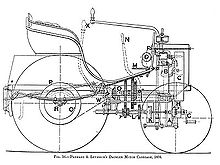From Wikipedia, the free encyclopedia
|
|
This article needs additional citations for verification. (October 2009) |
 |
|
| Industry | Manufacturing |
|---|---|
| Founded | 1891 |
| Founder(s) | René Panhard, Emile Levassor |
| Headquarters | Paris, France |
| Products | Cars |
Contents |
History
Panhard was originally called Panhard et Levassor, and was established as a car manufacturing concern by René Panhard and Émile Levassor in 1887.Their first car (based on a Daimler engine licence) was offered in 1890. Levassor obtained his licence from a friend who already had one, Sarazin. Upon Sarazin's death in 1887, Sarazin's widow married Levassor, and the deal was cemented. Daimler and Levassor became fast friends, and shared improvements with one another.
These first vehicles set many modern standards, but each was a one-off design. They used a clutch pedal to operate a chain-driven gearbox. The vehicle also featured a front-mounted radiator. An 1895 Panhard is credited with the first modern transmission. For the 1894 Paris–Rouen Rally, Alfred Vacheron equipped his 4 horsepower (3.0 kW; 4.1 PS) with a steering wheel, believed to be one of the earliest employments of the principle.[1][2]
In 1891, the company built its first all-Levassor design,[3] a "state of the art" model: the Systeme Panhard consisted of four wheels, a front-mounted engine with rear wheel drive, and a crude sliding-gear transmission, sold at 3500 francs.[3] (It would remain the standard until Cadillac introduced synchromesh in 1928.)[4] This was to become the standard layout for automobiles for most of the next century. The same year, Panhard shared their Daimler engine license with bicycle maker Armand Peugeot, who formed his own car company.
In 1895, 1,205 cc (74 cu in) Panhards finished first and second in the Paris–Bordeaux–Paris race, one piloted solo by Levassor, for 48¾hr.[5] Arthur Krebs succeeded Levassor as General Manager in 1897, and held the job until 1916. He turned the Panhard-Levassor Company into one of the largest and profitable manufacturer of automobiles before World War I.
Panhards won numerous races from 1895 to 1903. Panhard developed the Panhard rod, which became used in many other types of automobiles as well.
From 1925 the motors used Knight sleeve valves. That year a 4.8 litre (292ci) model set the world record for the fastest hour run, an average of 185.51 km/h (115.26 mph).
Panhard also produced railbuses, including some for the metre gauge Chemin de Fer du Finistère.
Post-war era
After World War II the company produced light cars such as the Dyna X, Dyna Z, PL 17, 24 CT and 24 BT. The company managed to get around a steel-saving government regulation forbidding new car models by making the bodies and several other components out of aluminum; the Dyna X and Z 1 had aluminum bodies. The later Dyna Z and the PL 17 bodies were steel. The styling was smooth and rounded, which stood out in any post-war parking lot.The 24 CT was a beautiful 2+2 seater; the 24 BT with a longer wheelbase had space for four.For a period after the war, the Panhard-based Monopole racing cars received unofficial support from Panhard (as did DB and other clients such as Robert Chancel), using it to good effect in winning the "Index of Performance" class at Le Mans in 1950, 1951, and 1952.[6] In 1953, Panhard moved on to a more direct involvement with Chancel, which however came to an end after the deadly 1955 Le Mans.[6] In the latter half of the fifties and the early sixties, the Deutsch Bonnet racers ("DB Panhard") picked up this mantle and went on to dominate the "Index of Performance" as well as other small-engine racing classes.
The last Panhard passenger car was built in 1967. From 1968 on, Panhard has only made armored vehicles—the civilian branch was absorbed by Citroën in 1965, and the marque was retired.
In 2004, Panhard lost a competition to another manufacturer of military vehicles, Auverland, for the choice of the future PVP of the French Army. This allowed Auverland to purchase Panhard in 2005, then a subsidiary of PSA Peugeot Citroën. However, the fame of Panhard being greater, it was decided to retain the name; the PVP designed by Auverland would bear a Panhard badge.
Car models
Panhard models
| Type | Construction period |
|---|---|
| Panhard Dyna X | 1945–1954 |
| Panhard Junior | 1951–1956 |
| Panhard Dyna Z | 1953–1959 |
| Panhard PL 17 | 1959–1965 |
| Panhard CD | 1962–1965 |
| Panhard 24 | 1963–1967 |
Models with Panhard technology
| Type | Construction period |
|---|---|
| Dyna Veritas | 1949–1954 |
| Rosengart Scarlette | 1952 |
| DB HBR 5 | 1954–1961 |
| DB Le Mans | 1958–1964 |
| Sera-Panhard | 1959–1961 |
Current military models
- AVL
- PVP
- PVPXL / AVXL: an enlarged AVL
- TC 54
- TC 10
- TC 24
- A3
- Peugeot P4
- ERC 90 Sagaie
- VBR: enlarged VBL multipurpose armored vehicle
- VAP: Véhicule d'Action dans la Profondeur (deep penetration vehicle), VBL based special operations vehicle
- VPS: P4 based SAS Patrol vehicle
Vehicles in service
Panhard has supplied more than 18,000 military wheeled vehicles to over 50 countries with a range of combat vehicles weighing less than 10 tonnes, as follows:- 5,400 armoured wheeled vehicles (AML, ERC 90 Sagaie, and LYNX VCR 6x6)
- 2,300 VBL in 16 countries which includes 1600 in service with the French Army
- 933 A4 AVL—PVP—selected by the French Army
- 9,500 vehicles under 7 tonnes; most being jeep-like vehicles produced under the Auverland name.
Gallery
-
Panhard & Levassor X46 2300cc (1924) saloon by Salmons and Son, Tickford
-
Panhard Cabrio-Coupé Pourtout
-
Panhard 24 CT, (1966)
































0 komentarai (-ų):
Rašyti komentarą